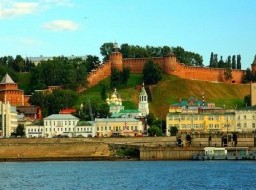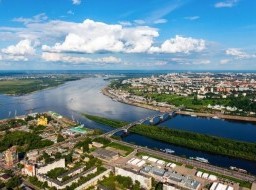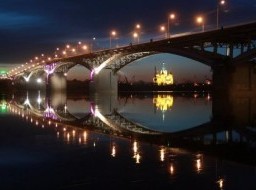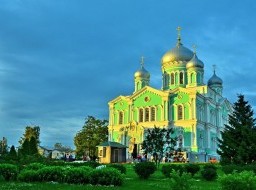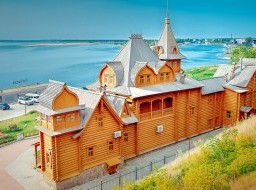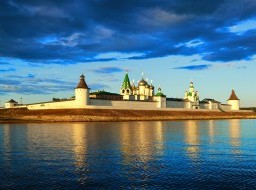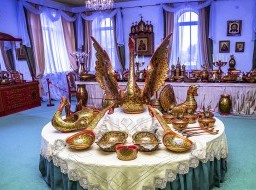Minin and Pozharsky Square
Minin and Pozharsky Square is the city's central square, named in honour of Kozma Minin and Prince Dmitry Pozharsky who led the people’s militia that liberated Moscow from the Polish-Lithuanian invasion during the Time of Troubles at the beginning of the seventeenth century. In the square, you will see a monument to Valery Chkalov, a native of Nizhny Novgorod, who completed the first non-stop flight from Moscow to Vancouver. The Minin and Pozharsky Square is the main square of Nizhny Novgorod, it is a social and cultural center of the city, the venue of the most important celebrations. It is located in the historical centre of the old town from the southeast side of the Kremlin. The square connects the central streets of the city: Bolshaya Pokrovskaya, Varvarskaya, Ulyanov, Minin, Upper Volga embankment and Zelensky Descent. There are many architectural monuments, the Minin University, Lobachevsky University and the Medical University; monuments to Minin, Chkalov; Exhibition Complex, as well as the first city fountain. The square is the roadway. Movement on it overlaps only on holidays and at the time of other events. HistoryRussian empire
Annunciation square and Annunciation Cathedral. Photo by Maxim Dmitriev
Initially, the square was unofficially called the Verkhneposadskaya, it was the center of the Upper Posad: here were overland trade routes, there was bargaining, to ensure the needs of the upper part of the city. In 1697 the Annunciation Cathedral was built and square was called Blagoveshchenskaya (Annunciation). The first regular plan of the square was drawn up in 1770, after the fire of 1768, at the request of the governorate authorities, a regular city development plan was drawn up in the St Petersburg Construction Commission, but the lack of local experienced urban planners hampered the implementation of the plan. According to the plan, square was trapezoidal, the plan fixed the directions of the departing streets and provided for the building of the square and adjoining streets only by stone houses. The transformation of the square began in 1779, when Yakov Ananin was appointed architect; in 1782, the ancient bridgeheads were dismantled, the ditch was filled. In its place rows of wooden trade stalls were built, during the general demarcation of the city in 1784-1787, new streets were laid and wooden buildings in the center of the square were destroyed. In 1787 a complex of buildings of the Post Office was built, the line between the Varvarskaya and Tikhonov (now Ulyanov) streets was occupied by the manor with the outbuildings of the vice-governor Pyotr Yelagin. Private houses on the sides of the square, which did not correspond to the plan, were preserved until the beginning of the 19th century, the buildings were not repaired, so that later they could be demolished. The Soviet period
Soviet Square. The 1920s
After the Russian Revolution, the Annunciation Square was renamed into Soviet Square. All the church utensils were plundered in the Annunciation Cathedral and the Church of St. Alexius the Metropolitan, and a variety of commercial shops were opened in the buildings themselves; in the 1930s of the 20th century, both churches were demolished. Also bolsheviks was demolished, recently installed, a monument to Alexander II, for a long time, only an empty pedestal remained, but it was also decided to destroy it. In 1935-1937, the Leningrad Institute "Giprogor" developed a general plan for the socialist city of Gorky (the name of Nizhny Novgorod in the Soviet period), which implied a radical change in the existing planning structure. Soviet Square at that time was designed round, its area significantly increased due to the demolition of some of the walls and towers of the Kremlin, which was perceived in those years as "a monument to avaricious feudalism and the tsarist autocracy, a witness to the terrible pages of the bloody past". The implementation of these projects was prevented by the outbreak of World War II in the Soviet Union. In 1943, at the regular meeting of the Gorky Regional Committee, it was decided to raise the morale of citizens, in the fight against Nazism, for this purpose, the first monument to Kuzma Minin was erected on the square. And it began to be called the Minin and Pozharsky Square, the citizens were inspired by such a gift. The townspeople always respected their ancestor very much and appreciated his feat. In 1985, the old monument to Minin was dismantled and sent to the restoration in Balakhna, where he remained. Four years later, in 1989, a new monument was erected by the Soviet sculptor Oleg Komov. Present timeAfter the dissolution of the Soviet Union, in the early 1990s, single stalls and trading tents began to be installed on the square. However, they did not stand long; in the early 2000s, an initiative was launched in the city to eliminate small retail outlets in central squares and streets. In early 2009, the administration of the city and the region considered the projects for the reconstruction of the Minin and Pozharsky Square, proposed by investors, the projects provided for the construction of an underground shopping and entertainment center. It was also proposed to restore the Annunciation Cathedral and the Church of St. Alexius the Metropolitan, the change in the habitual form of the square was regarded as unacceptable. The town-planning council under the governor approved one of the projects, despite the need for many years of preliminary work of archaeologists, as well as the danger of deteriorating the transport situation due to the emergence of an additional center of attraction. |

